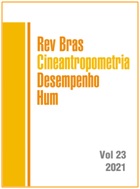Systematic review of active transportation to school in youth – an update from Brazil’s Report Card
DOI:
https://doi.org/10.1590/1980-0037.2021v23e81169Abstract
The aim of this study was to update a systematic review on the use of active transportation to school in Brazilian children and adolescents. All studies were extracted from the LILACS; BIREME; SCIELO and MEDLINE. The search was carried out on manuscripts published in the period 2018-2019. The descriptors were used in Portuguese, English and Spanish. In overall, 8 manuscripts were included in this systematic review, with 1 presenting data from three periods (2009, 2012 and 2015). The study data were obtained between 2009 and 2015 and the age group found between 7 to 19 years old. Of the selected articles, 2 presented national data, 1 from the north, 2 from the northeast, 1 from the southeast and 2 from the south of Brazil. The use of active transportation was superior to passive transportation on 6 occasions and its use was common in boys than in girls (4 of 6 articles). The use of active transportation is still more common than passive transportation in most Brazilian regions, although some cities have the opposite. The results suggest that the prevalence of active transportation is higher in boys than girls. Public policies must be created to favor the use of active transportation among Brazilian youth.
References
Katzmarzyk PT, Chaput JP, Fogelholm M, Hu G, Maher C, Maia J, Olds T, Sarmiento OL, Standage M, Tremblay MS, Tudor-Locke C. International Study of Childhood Obesity, Lifestyle and the Environment (ISCOLE): Contributions to Understanding the Global Obesity Epidemic. Nutrients. 2019 Apr 15;11(4):848.
Larouche R, Mammen G, Rowe DA, Faulkner G. Effectiveness of active school transport interventions: a systematic review and update. BMC Public Health. 2018;18(1):206.
Condello G, Puggina A, Aleksovska K, et al. Behavioral determinants of physical activity across the life course: a "DEterminants of DIet and Physical ACtivity" (DEDIPAC) umbrella systematic literature review. Int J Behav Nutr Phys Act. 2017;14(1):58.
Stewart T, Duncan S, Schipperijn J. Adolescents who engage in active school transport are also more active in other contexts: A space-time investigation. Health Place. 2017;43:25-32.
Villa-González E, Barranco-Ruiz Y, Evenson KR, Chillón P. Systematic review of interventions for promoting active school transport. Prev Med. 2018;111:115-134.
Ferrari GLM, Victo ER, Ferrari TK, Solé D. Active transportation to school for children and adolescents from Brazil: a systematic review. Rev Bras Cineantropom Desempenho Hum. 2018;20(4):406-14.
Diretrizes metodológicas: elaboração de revisão sistemática e metanálise de estudos observacionais comparativos sobre fatores de risco e prognóstico/Ministério da Saúde, Secretaria de Ciência, Tecnologia e Insumos Estratégicos, Departamento de Ciência e Tecnologia – Brasília: Ministério da Saúde, 2014
Smith M. Systematic Review Protocol. figshare. 2017. Retrieved September 26, 2017.
EndNote [http://endnote.com/.In]
National Heart, Lung and Blood Institute. Quality assessment tool for observational cohort and cross-sectional studies. Bethesda: National Institutes of Health, Department of Health and Human Services. 2014
Tan SS, Goonawardene N. Internet Health Information Seeking and the Patient Physician Relationship: A Systematic Review. J Med Internet Res 2017;19(1):e9
Higgins JP, Thompson SG, Deeks JJ, Altman DG. Measuring inconsistency in meta-analyses. BMJ. 2003; 327(7414): 557-60.
Ferreira RW, Varela AR, Monteiro LZ, Häfele CA, Santos SJD, Wendt A, Silva ICM. Sociodemographic inequalities in leisure-time physical activity and active commuting to school in Brazilian adolescents: National School Health Survey (PeNSE 2009, 2012, and 2015). Cad Saude Publica. 2018;34(4):e00037917.
Werneck AO, Oyeyemi AL, Fernandes RA, Romanzini M, Ronque ERV, Cyrino ES, Sardinha LB, Silva DR. Regional Socioeconomic Inequalities in Physical Activity and Sedentary Behavior Among Brazilian Adolescents. J Phys Act Health. 2018;15(5):338-344.
Mendonça G, Cheng L, Farias Júnior J. Padrões de prática de atividade física em adolescentes de um município da região Nordeste do Brasil. Ciênc Saúde Coletiva. 2018; 23(7): 2443-2451.
Silva AAP, Fermino RC, Souza CA, Lima AV, Rodriguez-Añez CR, Reis RS. Socioeconomic status moderates the association between perceived environment and active commuting to school. Rev Saude Publica. 2018;52:93.
Burgos MS, Tornquist D, Tornquist L, Reuter CP, Garcia EL, Renner JDP, Valim ARM. Cardiometabolic Risk Factors Associated with Active Commuting to School. Rev. Paul. Pediatr. 2019, 37, 181–187.
Ferrari GLM, Solé D, Pires C, Matsudo V, Katzmarzyk PT, Fisberg M. Correlates of body fat and waist circumference in children São Caetano do Sul, Brazil. Cien Saude Coletiva. 2019; 24(11): 4019-4030
Souza S, Carvalho W, Matos AP, Silva A, Oliveira E, Soares I, Bezerra S, Pereira B. Modes of commuting to school among 5th and 6th grade schoolchildren. Rev Bras Cineantropom Desempenho Hum 2019;21:e55564.
Farias ES, Carvalho WRG, Moraes AM, Santos JP, Gemelli IFB., Souza OF. Inactive behavior in adolescent students of the brazilian western amazon. Rev. paul. pediatr. 2019;37(3): 345-350.
Slingerland M, Borghouts LB, Hesselink MK. Physical activity energy expenditure in Dutch adolescents: contribution of active transport to school, physical education, and leisure time activities. J Sch Health. 2012;82(5):225-232.
Xu H, Wen LM, Rissel C. The relationships between active transport to work or school and cardiovascular health or body weight: a systematic review. Asia Pac J Public Health. 2013;25(4):298-315.
Staunton CE, Hubsmith D, Kallins W. Promoting safe walking and biking to school: the Marin County success story. Am J Public Health. 2003;93(9):1431-1434.
Giles-Corti B, Kelty SF, Zubrick SR, Villanueva KP. Encouraging walking for transport and physical activity in children and adolescents: how important is the built environment?. Sports Med. 2009;39(12):995-1009.
Buliung RN, Mitra R, Faulkner G. Active school transportation in the Greater Toronto Area, Canada: an exploration of trends in space and time (1986-2006). Prev Med 2009;48(6):507-12.
Camargo EM, Santos MPM, Ribeiro AGP, Mota J, Campos W. Interação dos fatores sociodemográficos na associação entre fatores psicossociais e transporte ativo para a escola. Cad. Saúde Pública. 2020;36(5):e00102719.
Rech CR, Camargo EM, Araujo PAB, Loch MR, Reis RS. Perceived barriers to leisure-time physical activity in the brazilian population. Rev Bras Med Esporte 2018;24:303-9.
Silva DAS, Lima JO, Silva RJS, Prado RL. Nível de atividade física e comportamento sedentário em escolares. Rev Bras Cineantropom Desempenho Hum. 2009;11(3):299-306.



